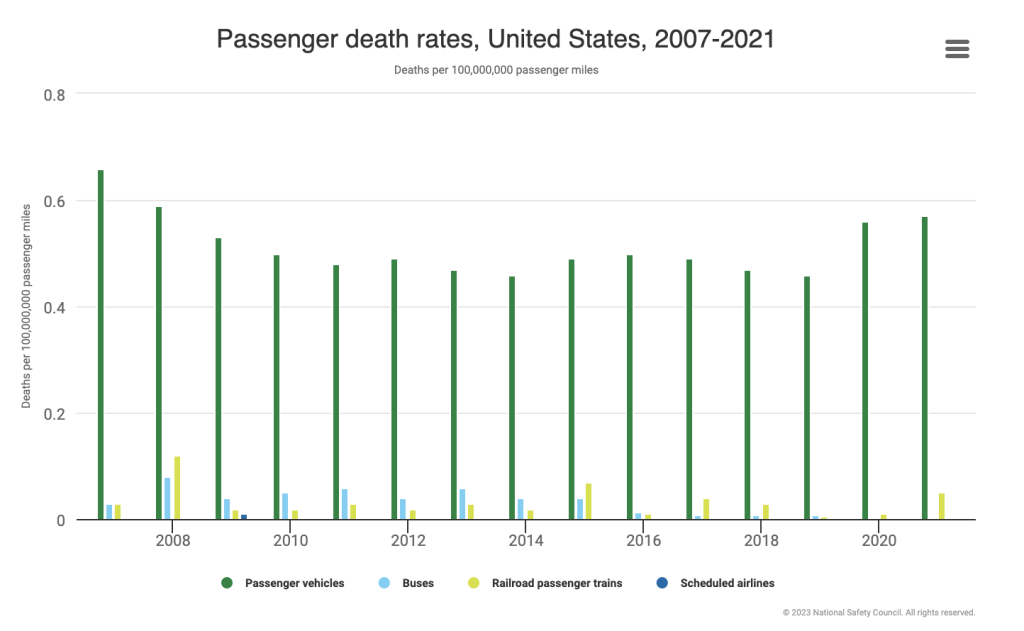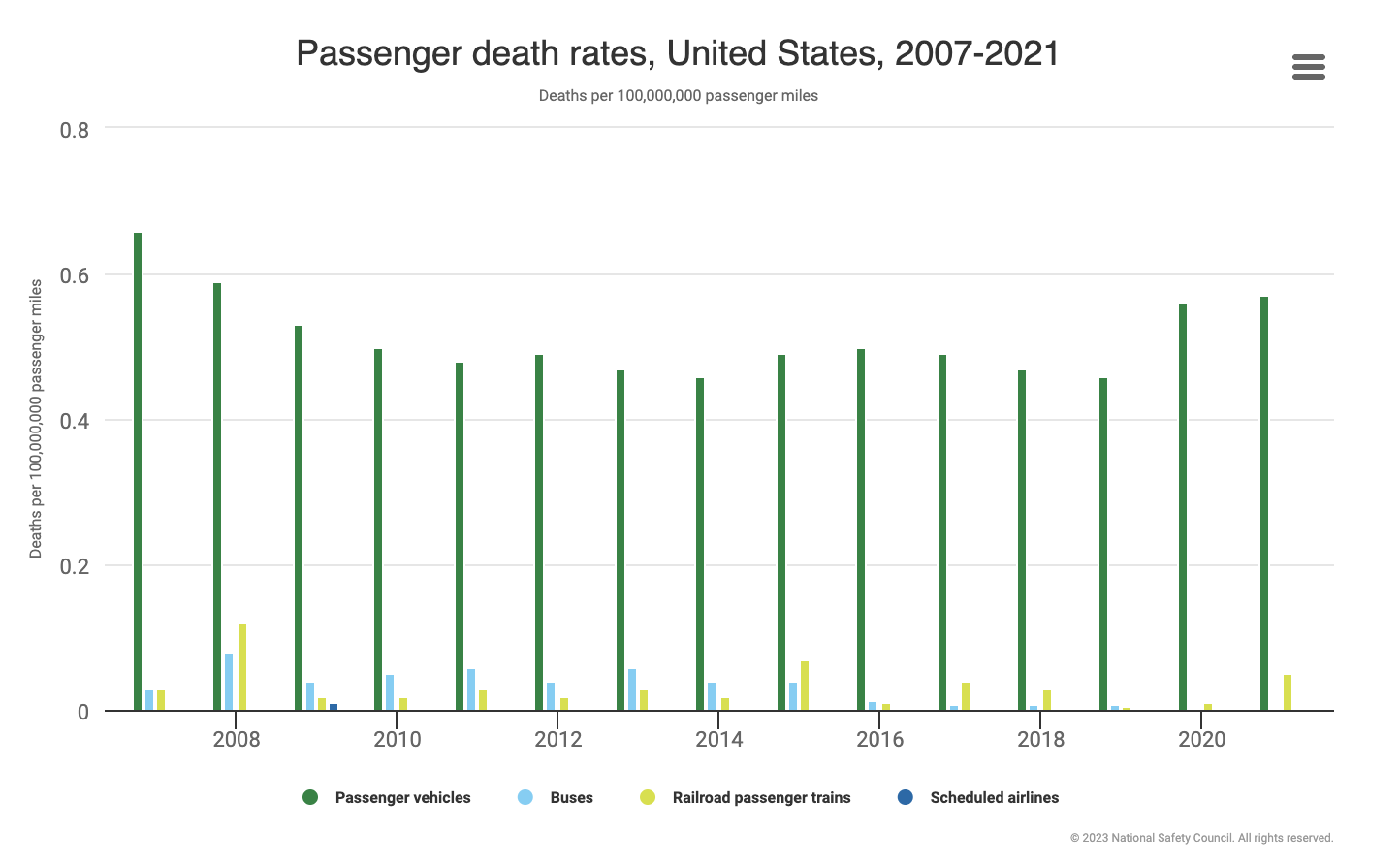Information and Statistics on Major Forms of Transportation
Are you wondering what the safest way to travel is? Some people who are afraid of flying on airplanes are especially interested in the answer to this question. What they, any many others, may not realize is that the way most people travel (by car) is in fact the most dangerous way to travel any far distance. This is according to fatal crash data statistics from around the world. Based on statistics related to fatalities per billion miles traveled, the modes of transportation can be ranked from safest to least safe as follows:
#1: Commercial Air Travel
#2: Bus Travel
#3: Train Travel
#4: Car Travel
#5: Motorcycle Travel
#6: Bicycle Travel
#7: Pedestrian Travel

How Many People Die Every Year? (by Method of Travel)
Here is a breakdown of the number of deaths per year by method of travel:
- Motor vehicle crashes: 42,939 people died on U.S. roads in 2021, according to the NHTSA. In 2020, an estimated 38,680 people were killed in motor vehicle crashes in the United States.
- Air travel: The number of fatalities in commercial airline crashes varies each year. In 2021, there were 21 reported deaths from commercial airline accidents in the U.S. In 2020, there were just 10. 2019 had 36. Overall, air travel has the lowest number of deaths in total and when calculating deaths per miles traveled.
- Railroad travel: The number of deaths per passenger-mile on rail travel in the United States is much lower than for motor vehicle travel. Only 6 passengers died on trains in the U.S. in 2021. 2 died in 2020 and only 1 died in 2019.
- Bus travel: According to the NHTSA, in 2021, only 16 bus passengers died from crashes. In 2020, it was only 12.
- Bicycling: According to the IIHS, a total of 961 people died in bicycle accidents in 2021. In 2020, 942 bicycles died.
- Pedestrian Travel: A total of 7,388 pedestrian deaths occurred in 2021, according to the Insurance Institute for Highway Safety (IIHS). Pedestrian fatalities increased 13 percent from 2020, and account for 17 percent of all crash fatalities. Although pedestrian deaths were 2 percent lower in 2021 than in 1975, they have increased 80 percent since reaching their lowest point in 2009. In 2020, an estimated 6,565 people were killed while walking in the United States.
We will dive further and provide additional statistics for the most popular methods of travel.
Commercial Air Travel
Air travel consistently stands out as one of the most secure means of transport due to its rigorous regulations, cutting-edge technology, and meticulous safety measures. Airlines are bound by exhaustive maintenance routines, training courses for pilots and crew members, and routine aircraft inspections. Moreover, aviation regulatory bodies impose strict safety guidelines to ensure compliance throughout the sector.
Flying is typically safer than driving for numerous reasons. One prominent factor is the higher density of cars on roads and highways, where vehicles are in close contact, thereby increasing the risk of accidents and crashes. In contrast, the concentration of aircraft in the sky is significantly lower, substantially reducing the chance of mid-air collisions.
Additionally, the licensing requirements and regulations for airplane pilots are more stringent than those for car drivers. The average driver does not encounter the same intensive training, sophisticated equipment, and strict rules that a professional pilot does. The safety of air travel is largely due to the multitude of regulatory procedures and extensive training that individuals working in the aviation industry, from pilots to aircraft dispatchers, are required to undergo.
Airplanes, marvels of contemporary technology and engineering, also enhance air travel safety. Commercial airplanes must comply with strict safety standards that are independent of the ticket class in which the passengers are seated. The industry’s technological advancements, with a focus on passenger safety, have resulted in airplane seats that can endure forces 16 times that of gravity. These seats are also fire-resistant and will not emit toxic fumes in the event of a fire. Thus, passengers, regardless of the price of their tickets, can be assured that their airplane seats are among the safest aspects within the industry.
Based on historical statistics and studies, air travel is statistically one of the most secure modes of transportation. The Aviation Safety Network reported that in 2020, there were 40 global accidents involving commercial flights, resulting in the tragic loss of 299 lives. Given that billions of people take flights annually, the expected fatality rate per 100,000 passengers is incredibly low, likely less than 1.
Private Planes
In contrast to commuter or commercial flights, private planes have a notably low statistical error when it comes to the fatality rate, displaying a consistent number of deaths each year. This stability allows for a more accurate assessment of the risks involved. Surprisingly, the data suggests that private planes can be 10 times more dangerous than cars.
The higher risk associated with private planes can be attributed to several factors, including lower levels of preparation and less stringent regulations compared to commercial flights. To provide some context, pilots for commercial airlines undergo three years of training, whereas obtaining a private pilot license can be accomplished within six months. Also, maintenance standards are much more rigorously regulated in commercial airlines compared to private planes.
Bus Accidents
Bus safety is a crucial aspect of public transportation, ensuring the well-being of passengers and minimizing the risk of accidents. Ranked second only to air travel, bus transportation stands as one of the safest modes of travel in the United States. Within the broad category of bus travel, which encompasses everything from school buses to charter coaches, airport shuttles, and municipal fleets, bus-related incidents account for only 10 percent of annual road fatalities. Comparatively, bus travel is four times safer than passenger rail travel, another notably secure mode of transportation, and an astonishing 50 times safer than traveling by private car. This remarkable safety record can be attributed to various factors, including the growing number of certified and licensed professional drivers, enhancements in roadway infrastructure, advancements in bus manufacturing technology, and the enforcement of stringent safety standards by the US Department of Transportation (DOT).
However, it is important to be aware of the statistics regarding bus fatality rates to fully understand the risks involved. According to available data, the fatality rate per 100,000 occupants in buses varies depending on various factors, including the type of bus (such as school bus, transit bus, or intercity bus) and the nature of the incident. On average, the fatality rate for bus occupants falls within a relatively low range of 0.05 to 0.25 deaths per 100,000 individuals. These numbers highlight the effectiveness of safety measures implemented in the bus industry, including seat belts, driver training, regular vehicle maintenance, and strict adherence to traffic laws. It is crucial for both bus operators and passengers to prioritize safety by following guidelines, fastening seat belts when available, and being vigilant during bus travel. By emphasizing bus safety measures and staying informed about statistics, we can continue to improve the overall safety of bus transportation systems. These combined efforts have contributed to the outstanding safety performance of buses in recent years.
Railroad Travel
Train travel also holds a commendable rank as a very safe mode of transportation, standing in third place after bus and air travel. Similar to air travel, train accidents, although rare, grab global headlines. It’s precisely the infrequency of these accidents that make them headline-worthy. Interestingly, the majority of injuries and fatalities related to trains are typically due to trespassing on active railway tracks and accidents at level crossings, indicating that commercial train travel remains a particularly safe means of transportation for passengers.
Trains are an effective mode of transportation across countries or continents, offering scenic vistas and comfort. They may be faster than air travel on certain routes, especially in countries with high-speed rail networks like Japan and France. In general, in general, train travel is considered to be one of the safer modes of transportation. According to the U.S. Bureau of Transportation Statistics, for instance, the fatality rate for train passengers is significantly lower than for drivers or passengers in cars.
Car Accidents
Driving safety is an essential part of preventing accidents and ensuring a smooth, stress-free journey. Passenger vehicles are by far the most dangerous motorized transportation option compared. In 2021, a total of 39,508 lethal accidents involving motor vehicles were reported, causing 42,939 fatalities. This led to a mortality rate of 12.9 individuals per 100,000 population and 1.37 deaths per 100 million miles traveled. From a statistical viewpoint, highway driving is the riskiest mode of transportation. The likelihood of a driver dying in a vehicular accident is 1 in 114, and as a passenger, it increases slightly to 1 in 654.
Motorcycle Accidents
Motorcycle riding, while offering a unique sense of freedom and exhilaration, also presents a significant risk when it comes to safety. According to statistical analyses, motorcyclists face a considerably higher mortality rate compared to drivers of other vehicles. The key factors contributing to this heightened risk involve a lack of physical protection, the smaller visual profile of motorcycles, and the requirement for a greater degree of skill and coordination. Nevertheless, adopting safe riding practices such as wearing appropriate gear, following traffic rules, maintaining safe speeds, and participating in advanced riding courses can help mitigate these risks, making motorcycle riding a safer and more enjoyable experience.
For example, A motorcyclist who journeyed 15 miles daily over the course of a year had an alarmingly high mortality risk, with a 1 in 860 chance of dying. Moreover, the per passenger mile death rate for motorcycles was found to be 29 times that of automobiles and light trucks. On the opposite end of the spectrum, the risk significantly decreased for aviation. If one were to take a 500-mile flight every single day for a year, the chance of fatality drops to a miniscule 1 in 85,000.
Sadly, motorcycles bear a high risk in terms of safety, with an alarming rate of 212.57 fatalities for every million miles traversed. To enhance your safety while riding a motorcycle, it’s crucial to don a protective helmet and adhere strictly to speed limits.
Boating Accidents
Traveling by boat is widely regarded as safer than car travel. Statistical data underscores this fact, with only 5-6 deaths per 100,000 recorded for registered recreational boats. This is in sharp contrast to the global fatality rate from road accidents, which stands at 18 deaths per 100,000 people annually.
While boating accidents are less frequent than road incidents, they still present a notable risk, particularly for those who frequently use water vessels for travel or leisure activities. Such accidents can involve various types of watercraft, ranging from personal watercraft and fishing boats to larger entities such as yachts and ferries. A myriad of factors can lead to these accidents, including operator distractions or inexperience, equipment malfunctions, severe weather conditions, and treacherous waters. The repercussions of these incidents can be grave, resulting in injuries, loss of life, and substantial property damage.
According to data from the U.S. Coast Guard, the mortality rate for boating stands at 5.4 deaths per every 100,000 registered recreational boats. Where the cause of death was identified, 75% of boating fatalities resulted from drowning. Shockingly, in situations where life jacket usage was documented, a considerable 85% of those who drowned were not wearing a life jacket. It’s imperative to understand that many boating accidents are avoidable. Observing safety guidelines, wearing life jackets, maintaining equipment, respecting weather and water conditions, and ensuring that operators are appropriately trained and sober can significantly mitigate accident risks.
Over the years, safety improvements in boat travel have been considerable, with its safety measures now rivaling those of commercial passenger train travel. However, it’s important to note that a majority, about 90%, of all boating deaths are associated with recreational boating rather than passenger boats, ferries, or cruise ships, which are more commonly used for travel by the general public.
Active Travel
Active travel, including modes of transportation such as walking and cycling, contributes greatly to public health by promoting physical activity and reducing carbon emissions. However, it also carries certain safety concerns. Statistics indicate that the pedestrian fatalities rate in the U.S. stands around 1.5-2 deaths per 100,000 population annually. For cyclists, it’s roughly 0.2-0.3 deaths per 100,000. These rates are significantly influenced by infrastructure and policy measures, with regions that have invested in pedestrian- and cycle-friendly infrastructure reporting lower rates of fatalities.
The main safety concerns around active travel revolve around interactions with motorized traffic, inadequate infrastructure for pedestrians and cyclists, and visibility issues. These risks can be mitigated through measures such as improved road design, better separation of motorized and non-motorized traffic, increased visibility through lighting and clothing, and comprehensive education for all road users on sharing the road safely.
Bicycle Accidents
Bicycle safety is a critical concern due to the vulnerability of cyclists on the road. According to the National Highway Traffic Safety Administration (NHTSA), there were approximately 2.3 deaths per 100,000 population from bicycle accidents annually in the United States. While cycling offers numerous benefits, it is essential to be aware of the risks associated with bicycle accidents. Statistics indicate that the fatality rate per 100,000 cyclists can vary depending on several factors such as location, infrastructure, and individual behavior. On average, the fatality rate for cyclists falls within a range of 2 to 9 deaths per 100,000 individuals.
This highlights the need for prioritizing safety measures while cycling, such as wearing a properly fitted helmet, obeying traffic rules, using designated bike lanes or paths, maintaining visibility with reflective clothing and lights, and being cautious of road conditions and other vehicles. Additionally, cyclists should regularly maintain their bicycles to ensure they are in good working condition. By adopting these safety precautions and staying vigilant on the road, cyclists can significantly reduce the risks associated with bicycle accidents and enjoy their rides safely.
Hiking Accidents
Hiking is a popular outdoor activity enjoyed by millions of people around the world. While it offers numerous physical and mental health benefits, it’s essential to prioritize safety to ensure a positive and secure experience. Understanding the risks associated with hiking and being prepared can significantly reduce the likelihood of accidents and injuries. According to statistics, the fatality rate per 100,000 hikers varies depending on factors such as location, trail difficulty, weather conditions, and individual preparedness. However, on average, the fatality rate for hiking falls within a relatively low range of 0.1 to 1.6 deaths per 100,000 hikers.
These numbers emphasize the importance of taking precautions such as researching the trail, carrying appropriate gear, dressing for the weather, staying hydrated, and informing others about your plans. Additionally, being aware of potential hazards like steep terrain, wildlife encounters, and sudden weather changes can help hikers mitigate risks and enjoy their outdoor adventures safely. Remember, hiking safety should always be a top priority to ensure a memorable and incident-free journey.
Understanding the safety statistics of different modes of transportation is vital for making informed decisions and prioritizing our well-being while traveling. Each mode of transportation carries its own risks, and being aware of the fatality rates can help us assess those risks more accurately. Regardless of the mode of transportation, prioritizing safety by following guidelines, using safety equipment, and staying informed about potential risks is crucial. By adopting a proactive approach to safety, we can make our journeys more secure and enjoyable.

